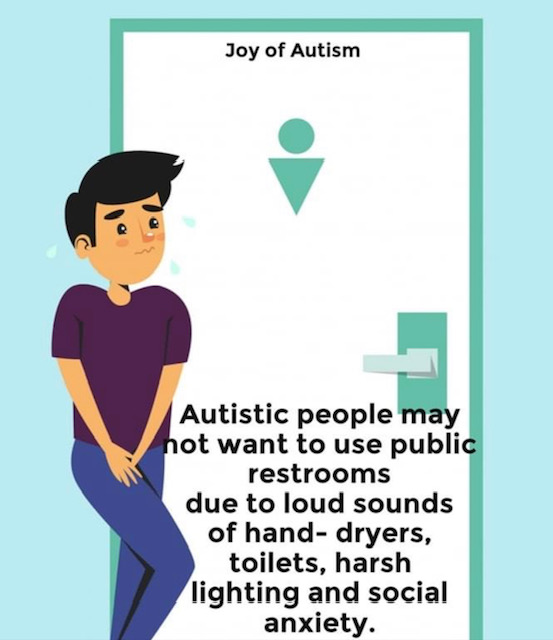When it comes to helping a child with autism learn to use a public restroom, there are a few things that can be done to make the process easier and less stressful for both the child and the caregiver. This was a major struggle when Justin was young. When he was a toddler and I could take him in with me it was ok but the older he got the more difficult it got. He wanted to use the men’s room not go in with his mom.It is important to understand that individuals with autism often struggle with sensory processing, meaning that they may be overwhelmed by certain sounds, sights, or textures. This can make public restrooms particularly challenging, as they tend to be noisy, crowded, and often have harsh lighting.To help alleviate some of these sensory issues, it may be helpful to bring along items that can provide comfort and familiarity, such as headphones to block out noise, a favorite toy or stuffed animal, or a visual schedule that outlines the steps involved in using the restroom. We also would take stickers with us to put over the automatic flush in the toilets that were too loud. Hand dryers also scared him.It can also be useful to practice using public restrooms in a low-pressure environment, such as a quiet park or a familiar store. This can help the child become more comfortable with the process and build confidence before attempting to use a busy public restroom.It may also be helpful to work with a therapist or behavior specialist who can provide additional strategies and support for teaching toileting skills to children with autism.Overall, it is important to approach the process with patience, understanding, and a willingness to adapt to the child’s individual needs and preferences. With the right support and guidance, it is possible for children with autism to successfully learn to use public restrooms and gain greater independence in their daily lives. It took a little while but we finally have conquered the public restroom.

1. Educate yourself: Start by learning as much as you can about autism. This can include reading books, articles, and online resources, as well as attending workshops and support groups. The more you know about autism, the better equipped you will be to advocate for your child and make informed decisions about their care. I would suggest buying some children’s books about autism too.2. Find a healthcare provider: Seek out a healthcare provider who has experience working with children with autism. This may include a pediatrician, developmental pediatrician, or neurologist. They can help you understand your child’s diagnosis and provide recommendations for treatment and therapy. We worked with all of these as well as a chiropractor.3. Consider early intervention: Early intervention services can be critical for children with autism. These services may include speech therapy, occupational therapy, and behavioral therapy. Talk to your healthcare provider or contact your local early intervention program to learn more about the services available in your area. If there is not a place that offers this service near you your insurance may send one to your home.4. Connect with other parents: Connecting with other parents of children with autism can be a valuable source of support and information. Consider joining a local support group or online community to connect with others who understand what you are going through. Connection with social groups and parents a little further along with autism will help. These lifelines really saved us. Just knowing someone else had been right where I was made it easier.5. Advocate for your child: Finally, it is important to be an advocate for your child. This may involve working with school staff to develop an Individualized Education Plan (IEP) or advocating for insurance coverage for therapy services. Remember that you are your child’s best advocate, and your voice can make a difference in ensuring that they receive the care and support they need. The most important thing to remember is you know your child better than anyone!
 Receiving an autism diagnosis can be overwhelming, but taking these steps can help parents feel more empowered and prepared to support their child. Remember to take things one step at a time and to celebrate your child’s strengths and accomplishments along the way. Your child too can overcome !!
Receiving an autism diagnosis can be overwhelming, but taking these steps can help parents feel more empowered and prepared to support their child. Remember to take things one step at a time and to celebrate your child’s strengths and accomplishments along the way. Your child too can overcome !!

